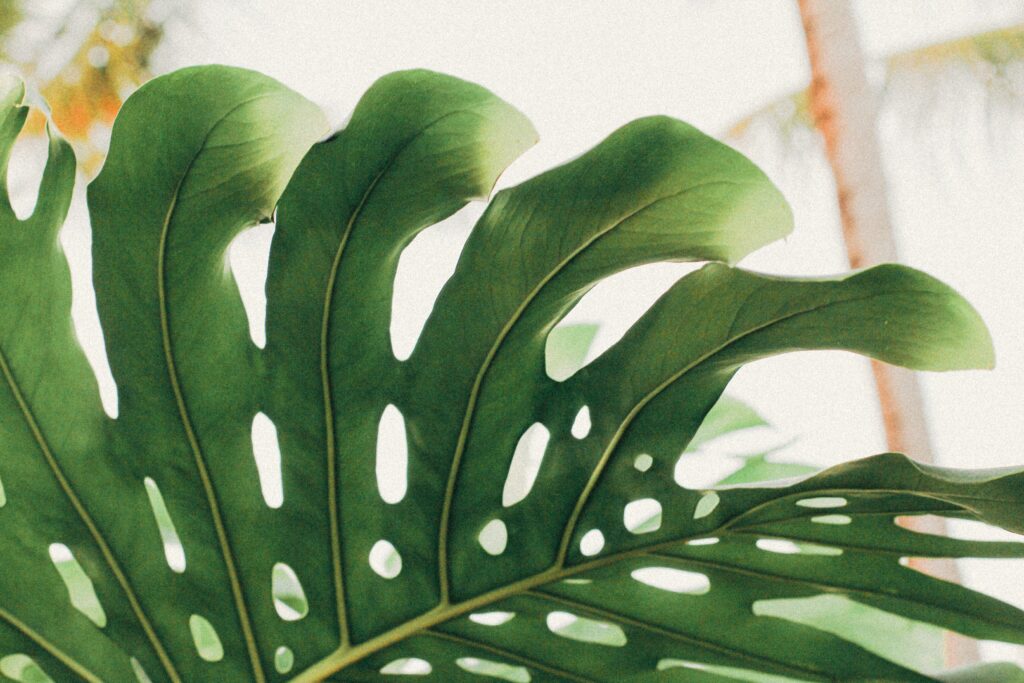It all starts with love at first sight. A perfectly healthy Monstera wins your heart in the nursery. You bring it home and do everything to make your plant happy. But the honeymoon is cut short. Yellowing leaves, brown leaves, root rot, stringy growth, or no growth at all. Monstera plant problems are common for new growers.
Luckily the fixes are straightforward, and these resilient plants are very forgiving. Read on as we dive into the most common Monstera plant problems and how to fix them quickly.
What is a Monstera?
The Monstera Deliciosa is a compact vine that can be found across plant retailers worldwide. The all-green “Deliciosa” variant is considered to be the entry-level member of the Monstera family, readily available in a variety of sizes at affordable prices.
They are easy to spot thanks to their signature big, beautiful dark green leaves. On mature plants, these leaves develop detailed fenestration patterns that give the Monstera its signature look.
Monstera Deliciosa houseplants are simple to keep happy. Bright light, moderate water, humidity and warm temperatures go a long way to keeping these plants growing. Their looks and care-free nature make Monsteras a great starter plant to start a plant collection. Veteran growers love Monsteras – whether it’s the classic Deliciosa or rarer variants like the hard-to-find Thai Constellation Monstera. Monstera plant problems are minimal, adding to their popularity.
🌿More to Explore. Read about other Monstera variants like the Thai Constellation or the Monstera Albo.
Monstera Plant Problems that Aren’t Actually Problems
Before we dive into everything that may be a plant issue, let’s first discuss things that may seem bad at first but are perfectly normal.
Oldest leaves dropping off
First, as your plant grows, its perfectly normal for older leaves near the base of the plant to slowly yellow or brown as the Monstera focuses energy on newer, larger leaves. This decline is perfectly natural, and keeps the focus on newer growth. If newer leaves appear discolored or damaged, that’s when it may be worth digging into issues impacting your plant.
Monstera vine growing sideways
In the wild, Monstera plants will attach themselves to trees, walls or other structures to help them climb. Their aerial roots help anchor the growing plant and keep it secure as it naturally gravitates upward.
At home, you may find your plant spreading out as it instinctually searches for a surface to climb. If you notice this sideways growth, you can attach the vine to a trellis or moss pole to encourage it to grow upwards.
Monstera Plant Problems: Leaf Issues
Yellowing leaves from over-watering
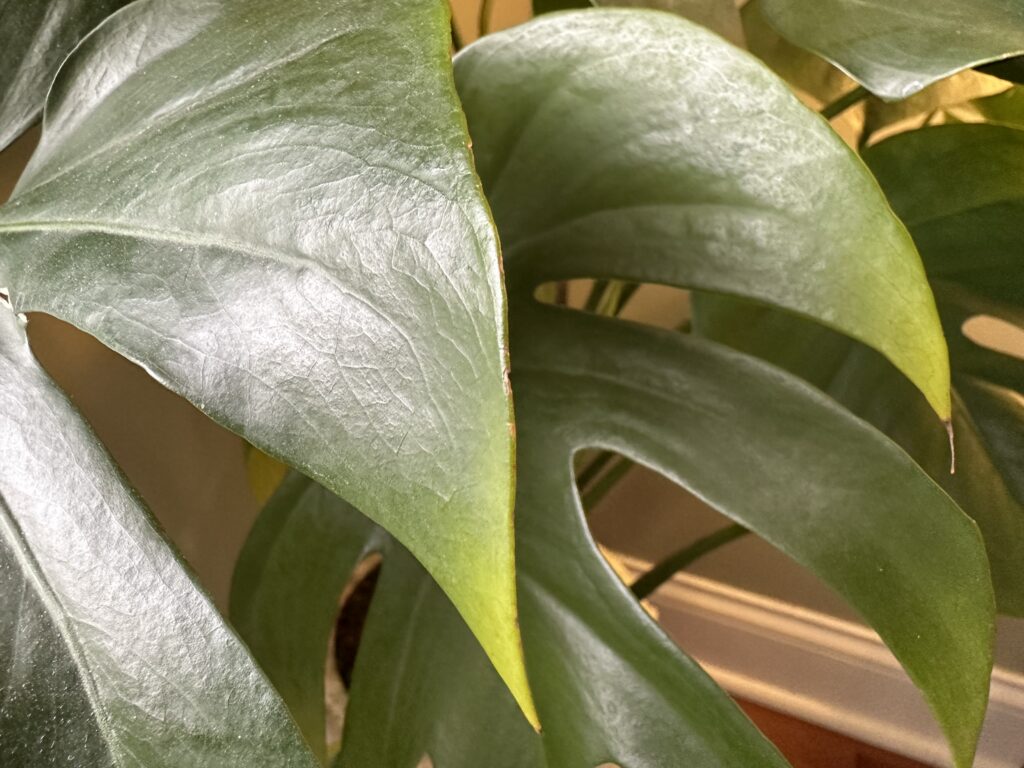
A common leaf issue facing Monsteras happens to be one of the easiest to fix. If you notice yellowing leaves forming at the outer leaf edges, you likely have an issue with over-watering your plant. Immediately stop your water schedule to allow your plant to dry out between waterings.
Water when the top 1” – 2” of soil dries out. Although they are tropical plants, Monsteras can start to decline if over-watered. Yellowing leaves are the first sign they are getting too much water.
Check out our comprehensive watering guide to develop your own schedule that will strike the right balance and satisfy your Monstera’s water needs.
Yellowing leaves from fertilizer issues
If your Monstera has yellowing leaves and you are not over-watering, your plant may be under-fertilized, and lacking nitrogen from the soil. Tropical plant fertilizers have an equal mix of nitrogen, phosphorous, and potassium – this is detonated as n-p-k on fertilizer labels. Yellowing leaves may be the result of low levels of nitrogen (n) or potassium (k).
Adding more fertilizer is an easy fix in this instance. Water-based fertilizers with an equal balance of nitrogen, phosphorous and potassium is recommended to avoid the guesswork of which specific nutrient your plant isn’t getting enough of. Follow the directions on the package for the right dosage and cadence for your plant.
Even if your plant isn’t experiencing decline, it’s recommended that you provide fertilizer during the spring and summer growing months.
Brown leaves from over-watering
Browning Monstera leaves can be a sign of watering issues, and can indicate that a plant is either over- or under-watered. If browning spots form within yellowing sections, this points to a severe case of over-watering. Brown sections of the leaf are likely dead and will not recover even if watering conditions improve.
Instead, focus on providing your plant with less water and watching for healthy new growth. Overwatering that results in browning leaves can indicate that your soil holds too much water, or that the pot lacks adequate drainage to keep water away from your plant’s roots.
If this is the case, the best option is to repot your plant into a pot that has plenty of drainage. Soil that is coarse and flushes excess water is ideal. I find substrate comprised of equal parts orchid bark and succulent soil work great for Monsteras. Our container breakdown can help you pick the best container to grow your plant in while managing water.
Brown leaves from under-watering
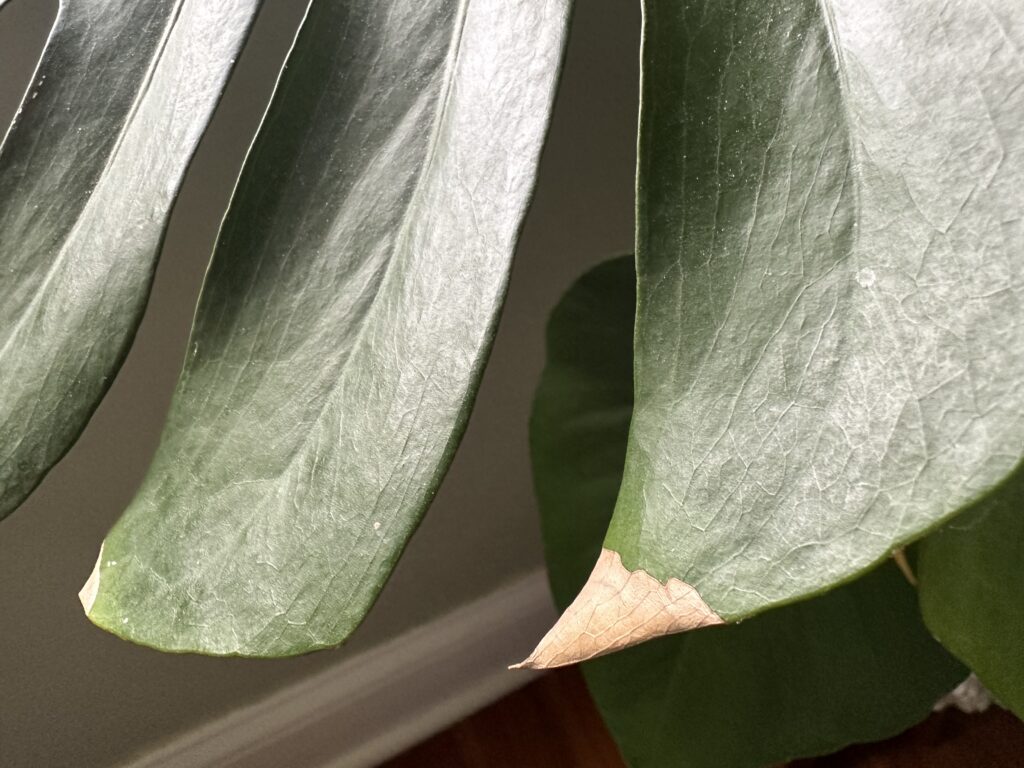
In cases of extreme water neglect, your Monstera will begin to wilt and develop brown, crunchy leaves as it pulls in moisture to the core of the plant.
Like the water issues above, the best way to combat this is to get into a regular watering habit. Any brown spots can be safely removed since they unfortunately won’t improve with new water. Instead, put a watering schedule in place and look for improvement with new leaves.
New leaves are growing in smaller
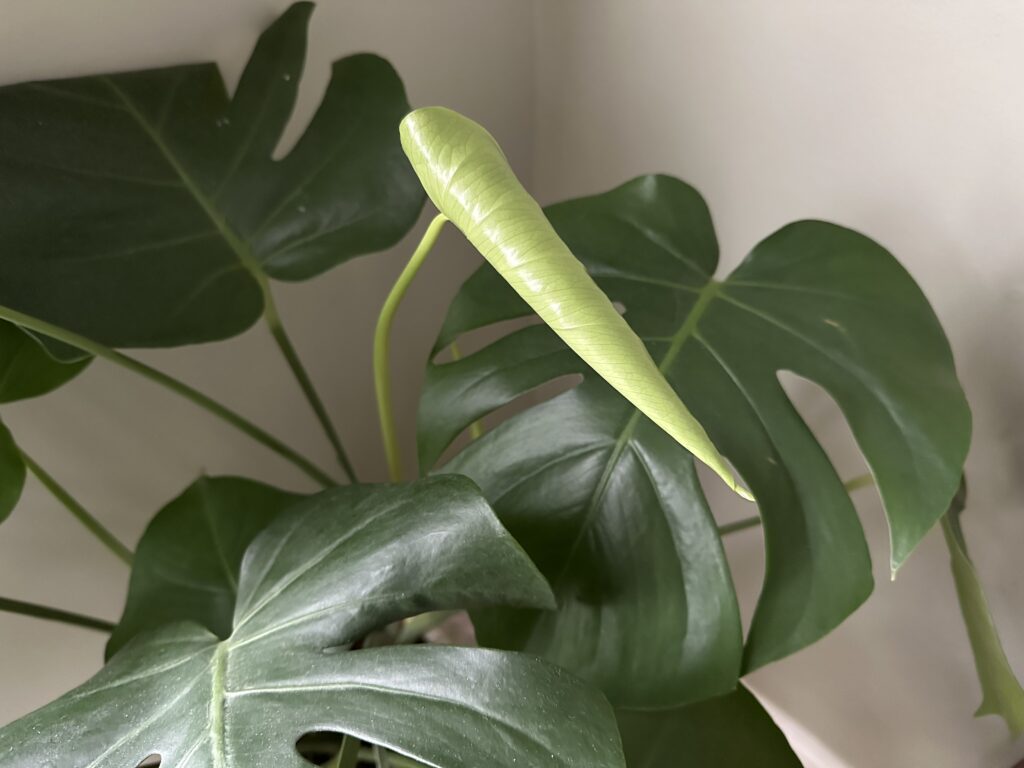
You might have the perfect watering schedule but notice that your plant is slow to produce new leaves. And new growth is small and unremarkable compared to older leaves. What gives?
Small leaves are a sign that your Monstera isn’t getting enough light. Producing a new leaf shoot takes the plant a considerable amount of energy. If the plant doesn’t have excess energy to prioritize for growth, the result will be your plant producing small leaves until lighting conditions improve.
Our Monstera lighting guide walks through everything you need to know about your plant’s light needs.
Leaves are not fenestrated
Fenestrated leaves are the signature of mature Monsteras, with their beautiful cuts that prevent wind damage and allow sunlight to filter down to older foliage.
Monsteras will not develop leaves with fenestrations until they are at least 1-3 years old. If older plants are continuing to produce the heart-shaped leaves of juvenile Monsteras, this is an indicator that the plant isn’t receiving enough lighting.
While your plant may be getting sufficient light to produce large leaves, it needs even more light energy to produce fenestrations.
Nurseries will describe Monsteras as growing in a variety of light conditions. This is technically true, as they won’t die in medium-indirect light. But to live up to their full potential, and develop leaves with true fenestrations, they need all the bright-indirect light you can provide. Sunny windows and LED grow lights can work together to maximize the light energy the plants can absorb, letting future leaves develop to their full potential.
Fenestrations take time
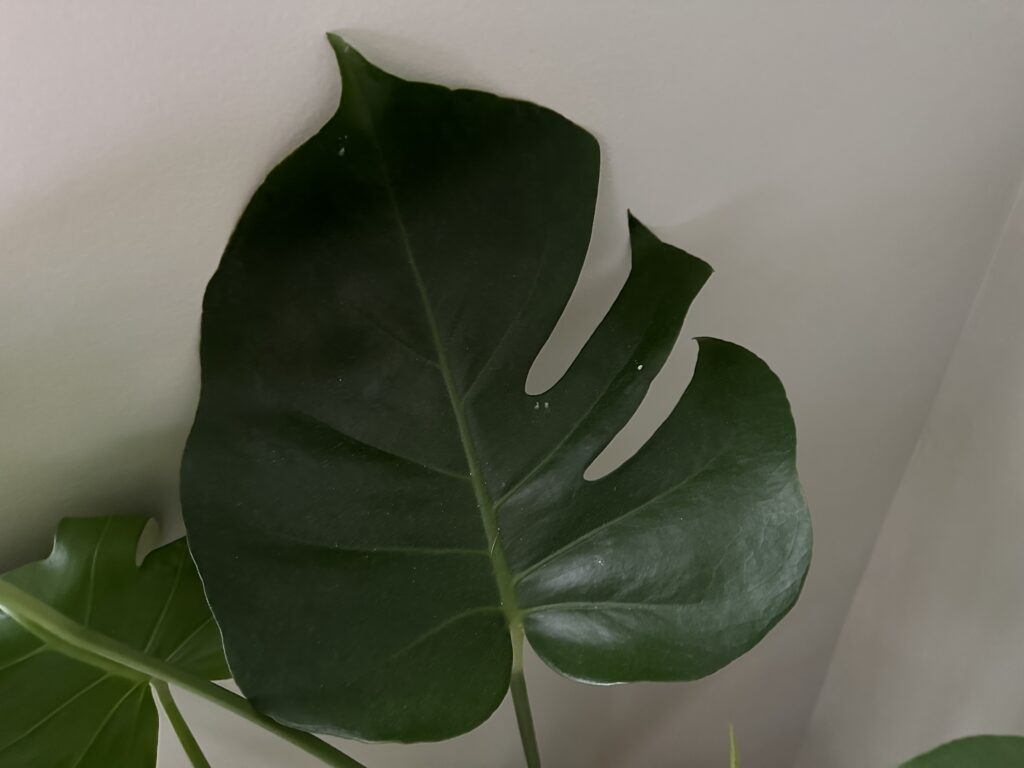
One more thing on fenestrations: the cut patterns will evolve over several leaf generations. If your first fenestrated leaf has only 1 or 2 “cuts” this is perfectly fine. Look for the next newest leaf to have more, and the newer one after that to have even more fenestrated cuts.
In especially bright conditions, mature plants will develop secondary fenestration bubbles inside of the primary leaf splits.
Do fenestrations appear after a Monstera leaf opens?
No, the fenestrations are fully formed in the unfurled leaf and will not appear after a leaf has already opened. You will only notice better fenestrations on future leaf shoots if ideal lighting conditions are kept.
Root Issues Causing Monstera Plant Problems
Root rot and root structure issues
We learned above that Monstera plants don’t like to be kept in standing water. One of the main reasons for this is that they are susceptible to root rot. Like the leaf issues mentioned above, the best way to combat this is with a regular watering schedule based on soil dampness, not a calendar schedule.
If root rot happens, you may notice your plant’s roots turning into sludgy black segments that don’t feel strong or “woody.”
Immediately cut back any roots that feel rotten to prevent the spread. If the rot works its way up to the vine of your Monstera, you may need to cut the root structure off completely, and potentially water propagate the vine or vine nodes in a water vase to encourage a new root structure to form.
While this process will take 1-2 months, it means that your plant may be salvaged or propagated into multiple plants from the same vine segment.
Monstera roots exposed from soil or in drainage holes
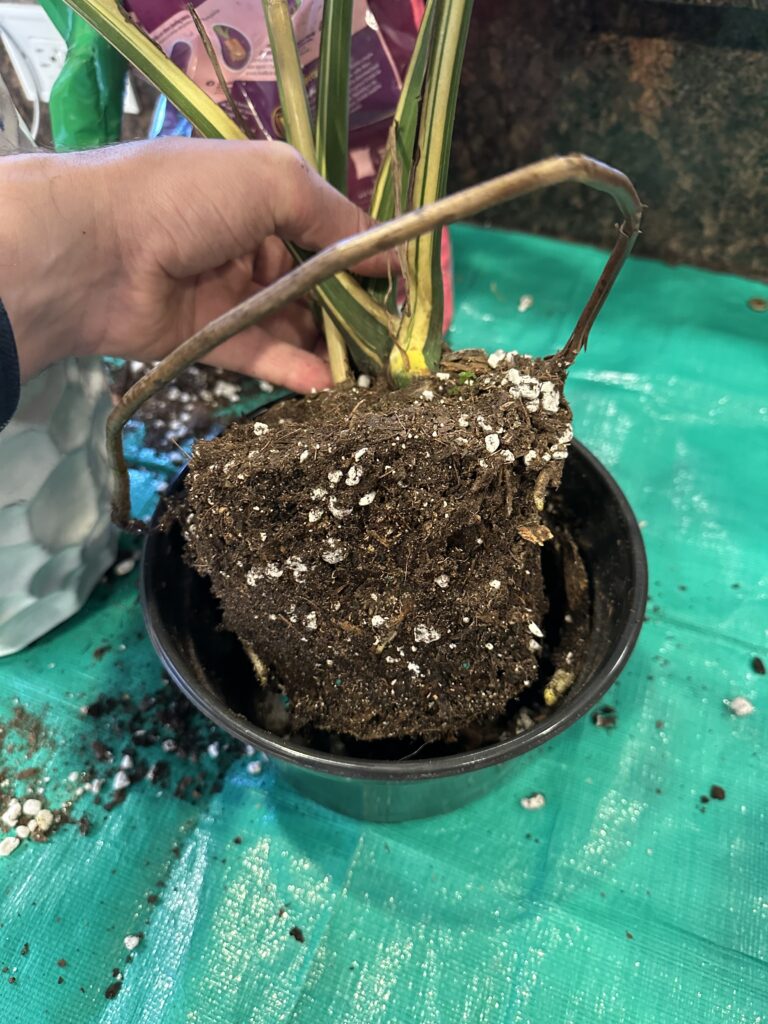
Noticing roots sticking up from the soil surface, or through the bottom drainage indicates that your plant is root bound. Your Monstera is out of space in its pot and needs a bigger home to keep growing.
The easy fix here is to upgrade its pot. It’s recommended that you only “size up” to the next largest pot from the previous container, by no more than 2” – 3” in diameter to avoid shocking your plant.
Our dedicated Monstera repotting guide will dive into the details on everything you need to successfully repot a root bound Monstera plant.
Monstera Plant Problems: Combatting Pests
While beautiful to us, Monstera houseplants are common targets of a variety of tropical plant pests. Spider mites, mealy bugs, scale, aphids, and gnats are common challenges Monstera growers face.
Neem oil is a naturally pesticide that will not damage your plant and is the most effective way to combat pets that may otherwise feed on your beautiful plant’s leaves, stems and roots.
While otherwise harmless, gnats or fruit flies are attracted to damp soil and may be brought home with a new plant or soil from the nursery. Our guide on exterminating gnats might help if you have the unfortunate luck to find a gnat infestation in your plants.
Monstera Plant Problems: Growth Issues
Slow growth with small leaves
If your noticing your Monstera has long, stringy vines and produces small leaves, this is a sign that your plant is desperate for more light. The stringy nature of the plant is its way of trying to “crawl” closer to a stronger source of light, and one of the most common Monstera plant problems.
If you notice this happening, an LED grow light is a great solution to adding more energy to your plant if it isn’t in a space with adequate sunlight. It may take time for your plant to absorb this new light and produce healthy growth, but it may save your plant from dying due to a lack of light energy.
No new growth for long periods of time
If your plant is not growing at all, it could indicate that one or more factors is off. If it’s the winter season and you live in an area that gets seasonably cold, your plant may be reacting to a lack of humidity in the air. Known to grow in high-humidity areas around the world, dropping the humidity will tell the plant not to grow as quickly. A pebble tray with water or a humidifier are both two ways to add much-needed moisture back into the air.
Beyond humidity, water conditions are another factor to investigate. Have you been cutting back on regular waterings? This may be telling the plant to slow down on growth. If soil feels bone-dry between waterings, you may be waiting too long to re-hydrate your plant. Instead, feel the soil, and when it no longer appears damp 1” – 2” deep, it means your Monstera is ready to be watered.
Finally, check the light. This is likely the biggest factor in telling your plant that there is enough energy to spend on producing a new leaf. Remember: new leaves take a lot of your plant’s energy to produce. Doing this without enough solar energy is a huge risk to your Monstera. Give them as much indirect light as you can, and supplement with grow lights if needed.
Get an even bigger dive in deeper to all things Monstera care with our comprehensive care guide.
Diagnosing Monstera Plant Problems: Wrapping Up
Monsteras are iconic plants and are popular all around the world. Not only beautiful, Monstera hosueplants are resilient and a great plant for new growers to learn with. Like all houseplants, Monsteras have potential care issues, but with the right conditions, you should have a healthy plant that grows for many years.

